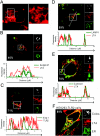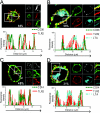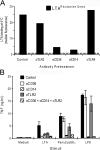Cellular trafficking of lipoteichoic acid and Toll-like receptor 2 in relation to signaling: role of CD14 and CD36
- PMID: 18458151
- PMCID: PMC3178504
- DOI: 10.1189/jlb.0907656
Cellular trafficking of lipoteichoic acid and Toll-like receptor 2 in relation to signaling: role of CD14 and CD36
Abstract
Lipoteichoic acid (LTA) is a central inducer of inflammatory responses caused by Gram-positive bacteria, such as Staphylococcus aureus, via activation of TLR2. Localization of TLR2 in relation to its coreceptors may be important for function. This study explores the signaling, uptake, and trafficking pattern of LTA in relation to expression of TLR2 and its coreceptors CD36 and CD14 in human monocytes. We found TLR2 expressed in early endosomes, late endosomes/lysosomes, and in Rab-11-positive compartments but not in the Golgi apparatus or endoplasmic reticulum (ER). Rapid internalization of fluorescently labeled LTA was observed in human monocytes, colocalizing with markers for early and late endosomes, lysosomes, ER, and Golgi network. Blocking CD14 and CD36 with antibodies inhibited LTA binding and LTA-induced TNF release from monocytes, emphasizing an important role for both molecules as coreceptors for TLR2. Importantly, blocking CD36 did not affect TNF release induced by N-palmitoyl-S-[2,3-bis(palmitoyloxy)-(2R,S)-propyl]-(R)-cysteinyl-seryl-(lysyl)3-lysine or LPS. Expression of CD14 markedly enhanced LTA binding to the plasma membrane and also enhanced NF-kappaB activation. LTA internalization, but not NF-kappaB activation, was inhibited in Dynamin-I K44A dominant-negative transfectants, suggesting that LTA is internalized by receptor-mediated endocytosis but that internalization is not required for signaling. In fact, immobilizing LTA and thereby inhibiting internalization resulted in enhanced TNF release from monocytes. Our results suggest that LTA signaling preferentially occurs at the plasma membrane, is independent of internalization, and is facilitated by CD36 and CD14 as coreceptors for TLR2.
Figures








Similar articles
-
TLR2 ligands induce NF-κB activation from endosomal compartments of human monocytes.PLoS One. 2013 Dec 12;8(12):e80743. doi: 10.1371/journal.pone.0080743. eCollection 2013. PLoS One. 2013. PMID: 24349012 Free PMC article.
-
Induction of TLR2 expression by inflammatory stimuli is required for endothelial cell responses to lipopeptides.Mol Immunol. 2008 Nov;46(1):145-57. doi: 10.1016/j.molimm.2008.07.017. Epub 2008 Aug 23. Mol Immunol. 2008. PMID: 18722665
-
Lipoteichoic acid of Streptococcus mutans interacts with Toll-like receptor 2 through the lipid moiety for induction of inflammatory mediators in murine macrophages.Mol Immunol. 2014 Feb;57(2):284-91. doi: 10.1016/j.molimm.2013.10.004. Epub 2013 Nov 12. Mol Immunol. 2014. PMID: 24216318
-
Cell biology of membrane trafficking in human disease.Int Rev Cytol. 2006;252:1-69. doi: 10.1016/S0074-7696(06)52005-4. Int Rev Cytol. 2006. PMID: 16984815 Free PMC article. Review.
-
To be more precise: the role of intracellular trafficking in development and pattern formation.Biochem Soc Trans. 2020 Oct 30;48(5):2051-2066. doi: 10.1042/BST20200223. Biochem Soc Trans. 2020. PMID: 32915197 Free PMC article. Review.
Cited by
-
Microbes little helpers and suppliers for therapeutic asthma approaches.Respir Res. 2024 Jan 13;25(1):29. doi: 10.1186/s12931-023-02660-7. Respir Res. 2024. PMID: 38218816 Free PMC article. Review.
-
A novel lipopeptide from skin commensal activates TLR2/CD36-p38 MAPK signaling to increase antibacterial defense against bacterial infection.PLoS One. 2013;8(3):e58288. doi: 10.1371/journal.pone.0058288. Epub 2013 Mar 5. PLoS One. 2013. PMID: 23472173 Free PMC article.
-
Host- and microbe determinants that may influence the success of S. aureus colonization.Front Cell Infect Microbiol. 2012 May 4;2:56. doi: 10.3389/fcimb.2012.00056. eCollection 2012. Front Cell Infect Microbiol. 2012. PMID: 22919647 Free PMC article. Review.
-
The comings and goings of MHC class I molecules herald a new dawn in cross-presentation.Immunol Rev. 2016 Jul;272(1):65-79. doi: 10.1111/imr.12428. Immunol Rev. 2016. PMID: 27319343 Free PMC article. Review.
-
Endosomal Cholesterol in Viral Infections - A Common Denominator?Front Physiol. 2021 Nov 11;12:750544. doi: 10.3389/fphys.2021.750544. eCollection 2021. Front Physiol. 2021. PMID: 34858206 Free PMC article. Review.
References
-
- Janeway C. A., Jr The immune system evolved to discriminate infectious nonself from noninfectious self. Immunol Today. 1992;13:11–16. - PubMed
-
- Medzhitov R., Janeway C. A., Jr Innate immunity: impact on the adaptive immune response. Curr Opin Immunol. 1997;9:4–9. - PubMed
-
- Marshall C., Kossmann T., Wesselingh S., Spelman D. Methicillin-resistant Staphylococcus aureus and beyond: what’s new in the world of the golden staph? ANZ J Surg. 2004;74:465–469. - PubMed
-
- Raetz C. R., Brozek K. A., Clementz T., Coleman J. D., Galloway S. M., Golenbock D. T., Hampton R. Y. Gram-negative endotoxin: a biologically active lipid. Cold Spring Harb Symp Quant Biol. 1988;53:973–982. - PubMed
-
- Raetz C. R., Ulevitch R. J., Wright S. D., Sibley C. H., Ding A., Nathan C. F. Gram-negative endotoxin: an extraordinary lipid with profound effects on eukaryotic signal transduction. FASEB J. 1991;5:2652–2660. - PubMed
Publication types
MeSH terms
Substances
Grants and funding
LinkOut - more resources
Full Text Sources
Other Literature Sources
Molecular Biology Databases
Research Materials
Miscellaneous

